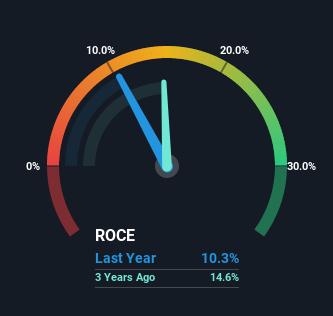To avoid investing in a business that’s in decline, there’s a few financial metrics that can provide early indications of aging. Typically, we’ll see the trend of both return on capital employed (ROCE) declining and this usually coincides with a decreasing amount of capital employed. Trends like this ultimately mean the business is reducing its investments and also earning less on what it has invested. So after glancing at the trends within Lear (NYSE:LEA), we weren’t too hopeful.
Understanding Return On Capital Employed (ROCE)
Just to clarify if you’re unsure, ROCE is a metric for evaluating how much pre-tax income (in percentage terms) a company earns on the capital invested in its business. Analysts use this formula to calculate it for Lear:
Return on Capital Employed = Earnings Before Interest and Tax (EBIT) ÷ (Total Assets – Current Liabilities)
0.10 = US$907m ÷ (US$14b – US$5.6b) (Based on the trailing twelve months to April 2023).
Thus, Lear has an ROCE of 10%. In absolute terms, that’s a pretty normal return, and it’s somewhat close to the Auto Components industry average of 12%.
View our latest analysis for Lear
In the above chart we have measured Lear’s prior ROCE against its prior performance, but the future is arguably more important. If you’d like, you can check out the forecasts from the analysts covering Lear here for free.
How Are Returns Trending?
In terms of Lear’s historical ROCE movements, the trend doesn’t inspire confidence. Unfortunately the returns on capital have diminished from the 23% that they were earning five years ago. Meanwhile, capital employed in the business has stayed roughly the flat over the period. This combination can be indicative of a mature business that still has areas to deploy capital, but the returns received aren’t as high due potentially to new competition or smaller margins. So because these trends aren’t typically conducive to creating a multi-bagger, we wouldn’t hold our breath on Lear becoming one if things continue as they have.
The Bottom Line On Lear’s ROCE
All in all, the lower returns from the same amount of capital employed aren’t exactly signs of a compounding machine. Long term shareholders who’ve owned the stock over the last five years have experienced a 30% depreciation in their investment, so it appears the market might not like these trends either. Unless there is a shift to a more positive trajectory in these metrics, we would look elsewhere.
One more thing, we’ve spotted 1 warning sign facing Lear that you might find interesting.
For those who like to invest in solid companies, check out this free list of companies with solid balance sheets and high returns on equity.
Have feedback on this article? Concerned about the content? Get in touch with us directly. Alternatively, email editorial-team (at) simplywallst.com.
This article by Simply Wall St is general in nature. We provide commentary based on historical data and analyst forecasts only using an unbiased methodology and our articles are not intended to be financial advice. It does not constitute a recommendation to buy or sell any stock, and does not take account of your objectives, or your financial situation. We aim to bring you long-term focused analysis driven by fundamental data. Note that our analysis may not factor in the latest price-sensitive company announcements or qualitative material. Simply Wall St has no position in any stocks mentioned.
Join A Paid User Research Session
You’ll receive a US$30 Amazon Gift card for 1 hour of your time while helping us build better investing tools for the individual investors like yourself. Sign up here
